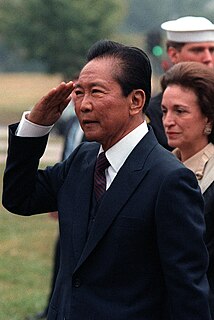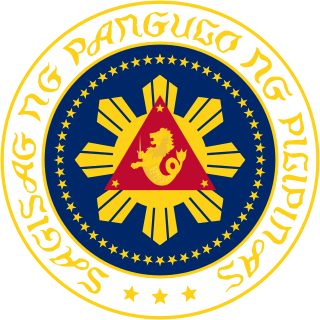
Ferdinand Emmanuel Edralin Marcos Sr. was a Filipino politician, lawyer, dictator, and kleptocrat who was the 10th president of the Philippines from 1965 to 1986. He ruled under martial law from 1972 until 1981 and kept most of his martial law powers until he was deposed in 1986, branding his rule as "constitutional authoritarianism" under his Kilusang Bagong Lipunan. One of the most controversial leaders of the 20th century, Marcos' rule was infamous for its corruption, extravagance, and brutality.

Benigno "Ninoy" SimeonAquino Jr., was a Filipino politician who served as a senator of the Philippines (1967–1972) and governor of the province of Tarlac. He was the husband of Corazon Aquino—who, after his death, eventually became the president of the Philippines—and father of a later president, Benigno Aquino III. Aquino, together with Gerardo Roxas and Jovito Salonga, helped form the leadership of the opposition towards then President Ferdinand Marcos. He was the aggressive leader who together with the intellectual leader Sen. Jose W. Diokno led the overall opposition.

The Communist Party of the Philippines is a far-left, Marxist-Leninist-Maoist revolutionary organization and communist party in the Philippines, formed by Jose Maria Sison on 26 December 1968. It is designated as a terrorist group by the United States Department of State together with Sison and its armed wing New People's Army (NPA) in 2002. The European Union renewed its terrorist designation on the organization in 2019, though a 2009 ruling by the EU's second highest court delisted Sison as a "person supporting terrorism" and reversed a decision by member governments to freeze assets. According to the US' Central Intelligence Agency (CIA) World Factbook, the CPP and the NPA aims to destabilize the Philippines' economy and overthrow the national government.

Jose Maria Canlas Sison, also known by his nickname Joma, is a Filipino writer, activist, and a terrorist who founded the Communist Party of the Philippines and added elements of Maoism to its philosophy — which would be known as national democracy. He applied the theory of Marxism-Leninism-Maoism to the history and current circumstances of the Philippines.

Jose Wright Diokno, also known as "Ka Pepe", was a Filipino nationalist, lawyer, and politician. Regarded as the "Father of Human Rights Advocacy in the Philippines", he served as Senator of the Philippines, Secretary of Justice, founding chair of the Commission on Human Rights, and founder of the Free Legal Assistance Group (FLAG), the premier group of Filipino human rights lawyers. Diokno is the only person to top both the Philippine Bar Examination and the board exam for Certified Public Accountants (CPA). His career was dedicated to the promotion of human rights, the defense of Philippine sovereignty, and the enactment of pro-Filipino economic legislation.

Proclamation No. 1081 was the document which contained formal proclamation of martial law in the Philippines by President Ferdinand Marcos, as announced to the public on September 23, 1972.

The history of the Philippines, from 1965 to 1986, covers the presidency of Ferdinand Marcos. The Marcos era includes the final years of the Third Republic (1965–1972), the Philippines under martial law (1972–1981), and the majority of the Fourth Republic (1981–1986). By the end of the Marcos dictatorial era, the country was experiencing a debt crisis, extreme poverty, and severe underemployment.

The Plaza Miranda bombing occurred during a political rally of the Liberal Party at Plaza Miranda, Quiapo district, Manila, the Philippines on August 21, 1971. It caused nine deaths and injured 95 others, including many prominent Liberal Party politicians.

The ongoing communist rebellion in the Philippines is a conflict between the government of the Philippines and the New People's Army (NPA), which is the armed wing of the Marxist–Leninist–Maoist Communist Party of the Philippines (CPP). The conflict is also associated with the National Democratic Front of the Philippines (NDFP), which serves as the legal wing of the CPP.

Martial law in the Philippines refers to the various historical instances in which the Philippine head of state placed all or part of the country under military control - most prominently during the administration of Ferdinand Marcos, but also during the Philippines’ colonial period, during the second world war, and more recently on the island of Mindanao during the administrations of Gloria Macapagal Arroyo and Rodrigo Duterte. The alternative term "Martial Law Era" as applied to the Philippines is typically used to describe the Marcos martial law period specifically.

Bernabe Buscayno, also called Kumander Dante, is the founder of the New People's Army, the military wing of the Communist Party of the Philippines.

The Bantayog ng mga Bayani, sometimes simply referred to as the Bantayog, is a monument, museum, and historical research center in Quezon City, Philippines, which honors the martyrs and heroes of the struggle against the dictatorship of former President Ferdinand Marcos.
It was in the late 1960s and early 1970s that the Philippines saw a surge in student activism. This could be chalked up to the onset of the Marcos administration and its declaration of Martial Law, which bore witness to tens of thousands of human rights violations, among many others. There are, however, several factors and events in Philippine history that contributed to the increase in student activism during this period. In fact, economic decline, increase in unemployment rates, the growth of intra-elite conflicts, and internal dissension and disruption all factored into the context of student activism in the Philippines. It was around this time that businesses in Manila tried to find opportunities to withdraw when the city started to be deemed unsafe. Five Communist oriented guerrillas in the countryside had also regained some of the momentum similar to the Huks had before they were contained by Magsaysay in the 1950s. The coming of a revolution was considered a possibility waiting to happen at one point as riots and demonstrations erupted, causing colleges to be closed down. All of these culminated in an effort to storm the Malacañang.
Liliosa Hilao was a Filipina student activist who was killed while under government detention during Martial Law in the Philippines, and is remembered as the first prisoner to die in detention during martial law in the Philippines. She was a student of Communication Arts at the Pamantasan ng Lungsod ng Maynila.
The Southern Tagalog 10 was a group of activists abducted and "disappeared" in 1977 during martial law in the Philippines under Proclamation No. 1081 issued by President of Philippines Ferdinand E. Marcos. Of the 10 university students and professors who were abducted, only three, Virgilio Silva, Salvador Panganiban, and Modesto Sison, "surfaced" later after being killed by suspected agents of the state. Two of those who surfaced were apparently summarily executed. The rest were never found.

Rizalina "Lina" P. Ilagan was an anti-martial law activist who belonged to a network of community organizations in the Southern Tagalog region in the Philippines.

At 7:17 pm on September 23, 1972, President Ferdinand Marcos announced on television that he had placed the entirety of the Philippines under martial law. This marked the beginning of a 14-year period of one-man rule that would effectively last until Marcos was exiled from the country on February 25, 1986. Even though the formal document proclaiming martial law – Proclamation No. 1081, which was dated September 21, 1972 – was formally lifted on January 17, 1981, Marcos retained essentially all of his powers as dictator until he was ousted.
The dictatorship of Philippine President Ferdinand E. Marcos in the 1970s and 1980s is historically remembered for its record of human rights abuses, particularly targeting political opponents, student activists, journalists, religious workers, farmers, and others who fought against the Marcos dictatorship. Based on the documentation of Amnesty International, Task Force Detainees of the Philippines, and similar human rights monitoring entities, historians believe that the Marcos dictatorship was marked by 3,257 known extrajudicial killings, 35,000 documented tortures, 77 'disappeared', and 70,000 incarcerations.
Bonifacio Parabuac Ilagan, often known just as Boni Ilagan, is a Filipino playwright, screenwriter, filmmaker, journalist, and editor best known for numerous socially-conscious, critically-acclaimed works in theater, film and television, most notably the films The Flor Contemplacion Story (1995), Dukot, Sigwa, and Deadline ; as well as his first play, Pagsambang Bayan (1976), which portrayed the human rights violations of the Marcoses. He is also one of the prominent torture victims who survived the Marcos dictatorship.

Historical distortion regarding Ferdinand Marcos is a political phenomenon in the Philippines. Ferdinand Marcos was the country's president between 1965 and 1986. Distortion, falsification, or whitewashing of the historical record regarding this period, sometimes referred to using the phrases "historical denialism", "historical negationism", or "historical revisionism" as an eupheminism for negationism, is an academically documented phenomenon linked to the return of Marcos' immediate family and political allies to government positions, as well as the hero's burial of Marcos himself in 2016. It continues Marcos' own efforts to create a cult of personality for himself, which in itself involved various forms of historical distortion.
















